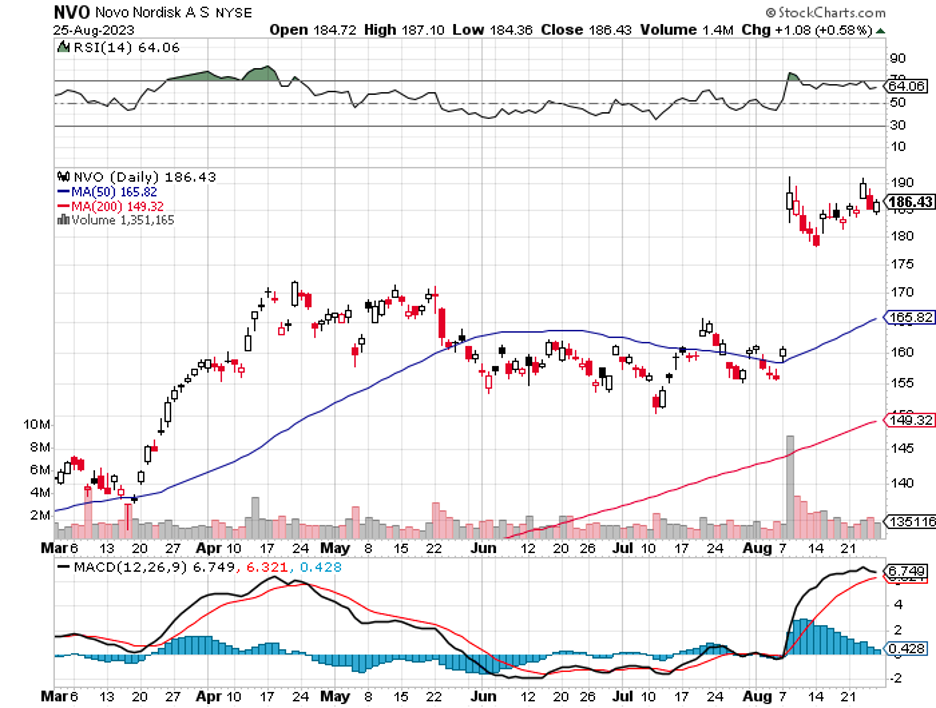These days, the narrative around transformative weight-loss drugs just got a little juicier. Here's the lowdown: Heart-failure patients are now giving a nod to Novo Nordisk’s (NVO) Wegovy. But, why?
The intel shows that the overweight community, grappling with heart woes, noticed a stamina uptick and weight drop when on Wegovy. The buzz was so compelling that it got its spotlight moment at the European Society of Cardiology Congress in Amsterdam. Plus, the New England Journal of Medicine gave it some ink.
Dive into the numbers, and you'll find that out of about 530 individuals with hearts not really pulling their weight (pun intended), the Wegovy brigade shed 13% of their body weight. That’s in stark contrast to the 3% that the placebo group managed.
More walking, less heart huffing-puffing - Wegovy users clocked in 17 times more steps on the treadmill and showcased fewer heart hiccups. Oh, and fewer side effects? Check.
Rewinding the tape, GLP-1 drugs initially stepped into the arena as the remedy for Type-2 diabetes. But then, surprise! Novo’s Ozempic and Eli Lilly’s (LLY) Mounjaro became the talk of the town. Not just because they were treating diabetes, but because those popping them shed an eye-catching 15% to 20% of their body weight. That's blockbuster material right there.
Eventually, Novo bagged the FDA's green light first for weight loss with Wegovy, and its demand skyrocketed so much so that medical maestros started prescribing Ozempic and Mounjaro to folks with weight woes. Now, all eyes are on the FDA's next move concerning Lilly’s weight-loss contender.
Now, here’s the kicker. This isn’t Wegovy’s first rodeo in the spotlight. Earlier this month, eyebrows were raised when it was revealed that these new kids on the block, known as GLP-1 agonists, might be the next superhero squad against a gamut of diseases.
Yet, GLP-1 might not just stop at obesity and heart diseases. It can also combat a spectrum of illnesses, including Alzheimer's. As expected, Novo and Lilly are doubling down on this potential, exploring these drugs' impact on liver and kidney diseases. As the benefits of GLP-1s unfold, insurers will probably be queuing up to offer coverage.
Let’s paint a clearer picture in terms of market potential.
Nearly 42% of U.S. adults grapple with obesity. The World Obesity Atlas dropped a bombshell—by 2035, over 4 billion global citizens might be tipping the scales, adding an astronomical $4 trillion in health costs.
The repercussions? Beyond the obvious heart diseases, strokes, and type 2 diabetes, they are also prone to mental health challenges, like depression and anxiety.
The economic ripples? Staggering. A drug that can be the silver bullet for such a widespread health epidemic could be the next Wall Street darling.
The next 10 years will likely see the GLP-1 agonists market touching an annual $86 billion. Yet, these figures might be leaning heavily on diabetes and off-label prescriptions.
With the World Health Organization cautioning about a billion obese and 2 billion overweight individuals by 2030, it's clear—this market is about to get a whole lot bigger.
With promises like these, it's no shocker that investors are tossing their coins into the ring. Both Novo and Lilly have seen their valuations triple, and Lilly's net worth now towers over its peers at a staggering $500 billion, crowning it the globe's pharmaceutical kingpin.
However, it’s wise to remember that it's one thing to climb the mountain and another to stay on the summit. Even in this early stage, competitors have started to emerge, including Amgen (AMGN), Sanofi (SNY), AstraZeneca (AZN), and Pfizer (PFE).
By 2025, the biopharma giants could potentially unveil their very own GLP-1-based wonder drugs for obesity, chipping away a quarter of Novo and Lilly's market dominance by 2032.
In the ever-evolving theater of biopharma, GLP-1 agonists, led by stalwarts like Wegovy, are emerging as the new front-runners. While the rewards seem tantalizingly vast, savvy investors know the pharmaceutical landscape is punctuated with highs and inevitable lows.
And here's a golden nugget: in the dynamic world of stock trading, every dip is an opportunity disguised as a setback. So, if you're seeking a stock market mantra for this burgeoning sector, remember to buy on the ebb, not the crest. It's in these valleys that fortunes are made, setting the stage for robust returns. Dive in wisely.


